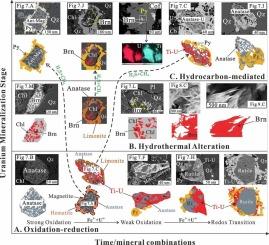Brannerite identification in the Louzhuangzi sedimentary U deposit and implications for deposit genesis or post-ore alteration
IF 3.6
2区 地球科学
Q1 GEOLOGY
引用次数: 0
Abstract
Brannerite (UTi2O6) is typically considered indicative of hydrothermal conditions in uranium mineral systems. In this study, we conducted a comprehensive mineralogical investigation of uranium-bearing sandstones from the Louzhuangzi area along the southern margin of the Junggar Basin. Scanning electron microscopy (SEM) and electron microprobe analysis (EMPA) were used to characterize the alteration features of titanium oxides. However, we recognize that SEM-EDS data alone are not sufficient for the conclusive identification of brannerite, as similar spectra may be produced by other titanium-uranium-bearing phases.
To overcome this limitation, focused-ion-beam (FIB) sample preparation combined with transmission electron microscopy (TEM) was employed to examine the crystal structure and nanoscale chemistry of selected titanium-uranium mineral particles. Selected-area electron diffraction (SAED) patterns and high-resolution TEM imaging, together with EDS elemental mapping, confirm the presence of discrete nanocrystalline brannerite aggregates. The identification of brannerite in the Louzhuangzi deposit suggests that hydrothermal activity played a role during ore formation or post-ore modification in this sandstone-type setting.
A comprehensive investigation indicates that uranium mineralization in the Louzhuangzi area is controlled by the coupled effects of oxidation, superimposed hydrothermal processes, and hydrocarbon-mediated fluid interactions.

娄庄子沉积型铀矿床中的银辉岩识别及其成矿后蚀变意义
银辉石(UTi2O6)通常被认为是铀矿系统中热液条件的指示物。本文对准噶尔盆地南缘娄庄子地区含铀砂岩进行了全面的矿物学研究。采用扫描电镜(SEM)和电子探针分析(EMPA)对氧化钛的蚀变特征进行了表征。然而,我们认识到,单独的SEM-EDS数据不足以确定银辉石,因为其他含钛-铀相可能产生类似的光谱。为了克服这一限制,采用聚焦离子束(FIB)制备样品结合透射电子显微镜(TEM)对选定的钛铀矿物颗粒的晶体结构和纳米级化学性质进行了研究。选择区域电子衍射(SAED)模式和高分辨率的TEM成像,以及EDS元素映射,证实了离散纳米晶银镁石聚集体的存在。娄庄子金矿床中银辉岩的鉴定表明,在该砂岩型环境中,热液活动在成矿或矿后改造过程中发挥了作用。综合研究表明,楼庄子地区的铀矿化受氧化作用、叠合热液作用和烃类流体相互作用的耦合控制。
本文章由计算机程序翻译,如有差异,请以英文原文为准。
求助全文
约1分钟内获得全文
求助全文
来源期刊

Ore Geology Reviews
地学-地质学
CiteScore
6.50
自引率
27.30%
发文量
546
审稿时长
22.9 weeks
期刊介绍:
Ore Geology Reviews aims to familiarize all earth scientists with recent advances in a number of interconnected disciplines related to the study of, and search for, ore deposits. The reviews range from brief to longer contributions, but the journal preferentially publishes manuscripts that fill the niche between the commonly shorter journal articles and the comprehensive book coverages, and thus has a special appeal to many authors and readers.
 求助内容:
求助内容: 应助结果提醒方式:
应助结果提醒方式:


